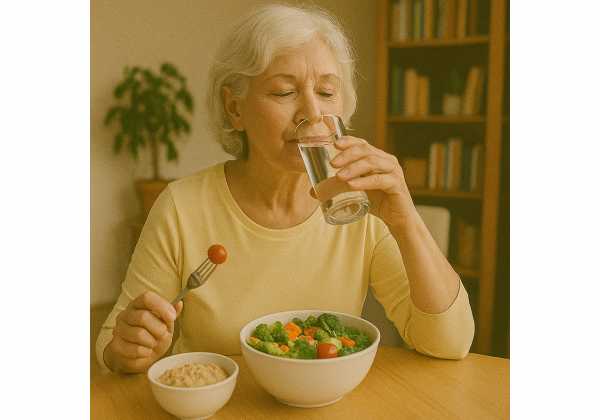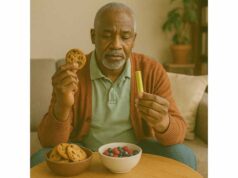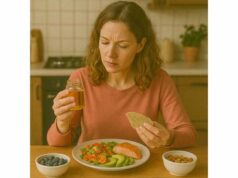
Constipation becomes more common with age, but it isn’t inevitable. Changes in gut motility, medications, mobility, and day-to-day habits all play a role—so your plan needs several levers: fiber quality and dose, fluid balance and electrolytes, meal timing, and targeted foods or supplements when needed. This guide translates the best evidence into practical, aging-aware steps you can apply this week. You will learn how to set a daily fiber goal that actually moves the needle, how to hydrate for comfortable stools, when breakfast and morning movement matter, and which foods and supplements have the strongest data. For broader context on a plate that supports a longer healthspan—including protein distribution, plant diversity, and polyphenols—see our overview of nutrition strategies for longevity.
Table of Contents
- Why Constipation Becomes More Common with Aging
- Daily Fiber Goals: Soluble vs Insoluble and Food Examples
- Fluids and Electrolytes: How Hydration Supports Regularity
- Meal Timing, Morning Routines, and Gut Motility Triggers
- Evidence Based Foods: Prunes, Kiwifruit, Flax, and Prebiotics
- When to Use Psyllium or Magnesium and What to Avoid
- Red Flags, Medications, and When to Seek Medical Care
Why Constipation Becomes More Common with Aging
Constipation is a symptom pattern, not one disease. In aging, several drivers stack up: slower colonic transit, reduced rectal sensation, pelvic floor discoordination, and lifestyle shifts like less walking and more time sitting. Medications common in later life—opioids, anticholinergics, some antidepressants, calcium channel blockers, iron, and calcium supplements—slow the gut or dry stools. Chronic conditions add layers: diabetes can impair nerve function in the gut; hypothyroidism and hypercalcemia reduce motility; Parkinson’s disease and stroke can disrupt coordination.
The stool you pass today reflects the last 24–72 hours of inputs. When meals are small and low in fiber, the colon reabsorbs more water and the stool becomes dry, hard, and harder to pass. Insufficient fluid intake adds to this dehydration. So does overuse of dehydrating beverages or diuretics without a balancing plan. On the flip side, rapid diet changes—like suddenly doubling fiber—can worsen bloating and discomfort until the microbiome adapts.
Normal frequency is broader than many assume. Some people are comfortable with a bowel movement every day; others feel fine with three per week if stools are soft and easily passed. What matters is ease, completeness, and avoidance of straining. A helpful target is one comfortable, formed bowel movement most days, without pain or prolonged time on the toilet.
Patterns to notice:
- Irregular meals or tiny dinners. A modest breakfast and a satisfying lunch can be better for motility than grazing all day.
- Low activity after meals. Even 10–15 minutes of walking after breakfast or lunch can stimulate the colon.
- Ignoring the urge. Regularly delaying bathroom breaks can dull rectal reflexes over time.
- Bathroom posture. Knees above hips (use a footstool) straightens the anorectal angle and reduces straining.
The theme across this article: build a repeatable morning routine, hit a realistic fiber and fluid goal, and add proven foods before reaching for harsher laxatives. When those steps are not enough—or red flags appear—pair nutrition with targeted medical therapies.
Daily Fiber Goals: Soluble vs Insoluble and Food Examples
Fiber is not one thing. Different fibers behave differently in water, in the microbiome, and in your colon. For constipation relief, the best evidence points to gel-forming soluble fibers, especially psyllium (Plantago ovata husk), and to adequate total intake sustained for at least four weeks.
Set a goal you can hit. A practical, effective range for older adults is 25–35 g fiber per day, split across meals and snacks. If you currently average far less, step up by 5 g every 3–4 days to reduce gas and cramping while your microbiome adapts.
Soluble vs insoluble in practice
- Gel-forming soluble fibers (psyllium, partially hydrolyzed guar gum, beta-glucan, pectins) absorb water, form a soft, viscous gel, and increase stool moisture and weight. This improves stool consistency and ease without causing urgency.
- Non-gelling soluble fibers (inulin, fructooligosaccharides, resistant dextrins) mainly feed microbes and generate short-chain fatty acids (SCFAs). They may help regularity for some people but can trigger gas if ramped quickly.
- Insoluble fibers (wheat bran, many vegetable skins, whole grain hulls) increase stool bulk and speed transit. Coarse wheat bran helps some, but for others it can worsen bloating or discomfort. Combine with gel-formers for balance.
What one day could look like (≈30 g fiber):
- Breakfast: ½ cup dry oats cooked (4 g) + 1 Tbsp ground flax (2 g) + 1 kiwi (2 g).
- Lunch: Lentil soup, 1½ cups (10–12 g).
- Snack: Pear (5–6 g).
- Dinner: Salmon with 1 cup broccoli (3 g) and ½ cup quinoa (2–3 g).
- Optional: Psyllium husk 1 rounded teaspoon in water (3–4 g).
Label literacy and dosing tips
- Check labels for “soluble fiber” grams and ingredients (“psyllium husk,” “psyllium seed husk”). For powders, a rounded teaspoon provides ~3–4 g psyllium; a heaping tablespoon ~5–7 g.
- Distribute fiber across meals. Your colon responds to steady input more than a single large bolus.
- Pair fiber with water (see the next section) so gels form properly.
- If you struggle to reach food-only targets, psyllium can safely fill the gap for many people.
To build a week of higher-fiber meals, see these food-first ideas in fiber planning for longevity.
Fluids and Electrolytes: How Hydration Supports Regularity
Soft, comfortable stools depend on water. Fiber draws and holds water in the colon; inadequate intake leads to dry, hard stools and straining. Many older adults drink less because thirst cues fade, bladder urgency is a concern, or diuretics increase urine output. The aim is not chugging—it’s consistent hydration matched to your day.
Set a personal baseline. A simple starting point is ~30 ml/kg/day of total fluids from beverages and high-water foods, adjusted for climate and activity. For many older adults this lands around 1.6–2.2 liters/day. If you take diuretics, live in hot weather, or exercise, your needs rise.
Electrolytes matter. Water follows sodium and potassium gradients. If you sweat or take diuretics, adding a pinch of salt to food and eating potassium-rich produce (leafy greens, beans, potatoes, squash) can help maintain balance. You rarely need commercial electrolyte drinks unless exercising hard, in heat, or with significant fluid losses; they can add unnecessary sugar. Lightly salted broth, mineral water, or diluted milk/yogurt drinks often work as well.
Hydration habits that help stools:
- Front-load daytime fluids. Aim for 500–700 ml before noon to support the morning gastrocolic reflex while reducing nighttime bathroom trips.
- Pair fiber with water. Take psyllium with at least 250 ml water; follow with sips during the next hour.
- Count watery foods. Soups, stews, yogurt, oranges, grapes, cucumber, and leafy salads contribute meaningfully to total fluids.
- Watch dehydrators. High alcohol intake, large caffeinated doses (for caffeine-sensitive folks), and very salty snacks can pull water away from the stool. A cup or two of coffee or tea can be helpful for some due to a mild stimulant effect—calibrate to your response.
Morning routine example (≈600–700 ml fluids): 300 ml water upon waking; breakfast tea or coffee (240 ml); water with breakfast (150–200 ml). Add a second 300 ml water mid-morning if stools remain hard.
When constipation comes with muscle cramping or very low dietary magnesium, a diet richer in magnesium-containing foods—pumpkin seeds, almonds, leafy greens, beans—supports neuromuscular function. A subset of people benefit from osmotic magnesium salts (see Section 6) that draw water into the colon; these require thoughtful dosing and attention to kidney function.
For broader hydration planning by day and activity, see hydration and electrolytes for healthy aging.
Meal Timing, Morning Routines, and Gut Motility Triggers
Your colon is most responsive in the morning. Waking ramps the autonomic nervous system and the gastrocolic reflex, a natural surge in colonic motility after eating. Older adults can harness this by pairing a predictable breakfast, warm beverages, and short movement with unhurried bathroom time.
Design a 30–40 minute morning sequence:
- Hydrate on waking. 300 ml water within 15 minutes of getting up.
- Warm drink. Coffee or tea can enhance the gastrocolic reflex for many people.
- Breakfast with fiber and protein. Oats with flax and fruit; or eggs with sautéed greens and beans.
- Move. 10–15 minutes of easy walking or gentle stair climbs.
- Bathroom window. Sit with feet on a small stool (knees above hips) and relax the belly; avoid straining. If no urge, try diaphragmatic breathing (4–5 slow belly breaths).
Meal size and timing across the day
- A modest breakfast plus a solid lunch often beats a tiny breakfast and large late dinner for motility and sleep.
- Finish larger meals 3–4 hours before bed. Late heavy dinners can dull morning hunger and reduce the next day’s reflex.
- Consistency wins. Your enteric nervous system adapts to routine. Even on weekends, keep the same breakfast window.
Movement micro-doses
- Post-meal walks: 10 minutes after breakfast and lunch reduce colonic transit time and improve glucose control.
- Light core work: Pelvic tilts, gentle spinal twists, and knees-to-chest stretches ease abdominal tension.
- Pelvic floor therapy: If you strain regularly or feel blockage despite soft stools, ask your clinician about pelvic floor physiotherapy and biofeedback.
What to watch
- Skipping breakfast and long fasting can be fine for some metabolic goals but may reduce morning motility. If constipation worsens, reintroduce a small breakfast with fiber and fluids.
- Frequent travel and schedule changes unsettle the gut. Pack familiar breakfasts, a water bottle, and a small footstool alternative (stacked books) to keep posture and routine intact.
If you want to align meals with your body clock to support both motility and sleep, explore meal timing strategies anchored to circadian rhythms.
Evidence Based Foods: Prunes, Kiwifruit, Flax, and Prebiotics
Food interventions can be powerful, especially when paired with routine. Four standouts—prunes, green kiwifruit, ground flaxseed, and prebiotic fibers—have evidence for improving stool frequency and/or consistency while being easy to add to meals.
Prunes (dried plums) or prune juice
- Prunes provide sorbitol (a sugar alcohol that draws water into the colon), soluble fiber (pectin), and polyphenols that may support microbial diversity.
- Practical dose: 50–100 g prunes/day (about 5–10 prunes) or ~60 ml prune concentrate diluted in water. Start low to limit gas and cramping; split into two servings.
- Tips: Chop into oatmeal, blend into a smoothie with yogurt, or pair with walnuts and cinnamon. Prune juice can be used as a gentle evening option if mornings are difficult.
Green kiwifruit (Actinidia deliciosa)
- Two green kiwis per day (not gold, which has different fiber and enzyme profiles) have been shown to increase complete spontaneous bowel movements and improve abdominal comfort in people with constipation and IBS-C.
- Dose and timing: 2 kiwis/day, ideally with breakfast and lunch. Peel or eat with skin (if tolerated) for extra fiber.
- Backup plan: If fresh kiwis are not available, canned or frozen can work; look for no-sugar-added options.
Ground flaxseed
- Delivers soluble and insoluble fibers plus alpha-linolenic acid (ALA) and lignans.
- Dose: 1–2 tablespoons/day (about 7–14 g). Grind just before use or store ground flax in the freezer.
- Use: Stir into yogurt, oats, or soups; whisk into salad dressing. Pair with an extra 200–300 ml water.
Prebiotic fibers from foods
- Inulin/GOS occur in onions, leeks, garlic, asparagus, Jerusalem artichoke, and some legumes; they feed beneficial gut bacteria and increase SCFA production, which can promote motility.
- If gas-sensitive, introduce small amounts (1–2 Tbsp chopped onions in cooked dishes) and increase gradually. Cooking and fermenting often improve tolerance.
Putting it together
- Choose one food to trial for 2–4 weeks, then keep it if it helps.
- Combine with your baseline fiber goal; do not stack several new fibers at once.
- If constipation persists despite these foods and adequate fluids, consider a gel-forming fiber supplement (psyllium) or an osmotic agent (magnesium) under guidance (see next section).
For a deeper dive into microbe-feeding fibers and how to add them gently, see prebiotic fibers for longevity.
When to Use Psyllium or Magnesium and What to Avoid
When food-first steps are not enough, two options often work well and safely for older adults when used correctly: psyllium and magnesium salts. They act differently, so your choice depends on your stool pattern, hydration, and health history.
Psyllium (gel-forming soluble fiber)
- How it works: Absorbs water, forming a soft gel that increases stool moisture and weight. Improves stool consistency and frequency without urgency.
- Dose: Start with 3–5 g once daily (e.g., a rounded teaspoon of psyllium husk in 250 ml water). After 3–4 days, increase to 5–10 g/day, split morning and evening if needed. Many trials used ≥10 g/day for best effect over ≥4 weeks.
- Tips: Mix in water or dilute juice, stir briskly, and drink promptly. Follow with additional sips of water across the next hour. Pair with your morning routine for consistency.
- Who benefits most: Hard, dry stools; straining; irregular intake of fiber-rich foods.
- Cautions: Take 2–3 hours apart from some medications to avoid binding. Ramp slowly to limit gas.
Magnesium salts (osmotic laxatives)
- How they work: Draw water into the intestinal lumen to soften stool and stimulate motility.
- Common forms and starting doses:
- Magnesium citrate powder: start 100–200 mg elemental magnesium in the evening; adjust by 50–100 mg every few nights to a soft stool.
- Magnesium oxide tablets: start 250–400 mg in the evening; titrate carefully.
- Hydration: Take with a full glass of water.
- Safety: Check kidney function if you have chronic kidney disease; avoid high doses if eGFR is low or if you take medications that raise magnesium. Stop and seek medical advice for persistent diarrhea, cramping, or weakness.
- Who benefits most: Those who already hit fiber goals yet still pass hard stools, or those who need a predictable softening effect.
What to avoid or de-emphasize
- Docusate (stool softener) alone has limited benefit for chronic constipation.
- Bulky coarse wheat bran can worsen bloating for some; if you try it, start small and combine with gel-forming fiber.
- Castor oil and strong stimulant laxatives used daily can lead to cramping and dependency. Reserve stimulant agents for short, targeted use as guided by your clinician.
- “Detox teas” and harsh herbal blends often contain senna or cascara at unpredictable doses.
If supplements remain confusing, bring your weekly stool log to your clinician. A combined plan—psyllium in the morning and low-dose magnesium in the evening—works well for many, provided kidney function is sound and hydration is adequate.
Red Flags, Medications, and When to Seek Medical Care
Constipation responds to routine in most cases, but certain features require prompt evaluation. Seek medical care if any of the following occur:
- Alarm symptoms: unintentional weight loss, blood in stool (or black tarry stools), iron-deficiency anemia, fever, new severe abdominal pain, rectal bleeding, or vomiting.
- A sudden, persistent change in bowel habits after age 50.
- Family history of colorectal cancer, inflammatory bowel disease, or celiac disease.
- Neurologic red flags: progressive weakness, numbness in the saddle area, or loss of bowel/bladder control.
- Refractory constipation despite 4–6 weeks of optimized fiber, fluids, morning routine, and a trial of psyllium or magnesium.
Medication review checklist
- Constipating drugs: opioids; anticholinergics (e.g., oxybutynin, some antihistamines); calcium channel blockers (verapamil); iron or calcium supplements; some antacids (aluminum, calcium).
- Adjustments to discuss: switching to magnesium-based antacids if appropriate; changing iron formulation or dosing schedule; evaluating antidepressants with lower anticholinergic burden; adding a prophylactic bowel regimen if opioids are necessary.
- Supplements: high-dose calcium without balancing magnesium; low-fiber meal replacements; dehydrating herbal diuretics.
When medical therapies are appropriate
If nutrition and lifestyle measures are optimized but symptoms persist, evidence-based pharmacologic options (e.g., polyethylene glycol, secretagogues like linaclotide or plecanatide, prucalopride) can be layered in safely for older adults under medical supervision. Patients with pelvic floor dyssynergia often benefit from biofeedback therapy, which retrains muscles for complete, strain-free evacuation.
Prepare for your appointment
- Bring a two-week stool diary with Bristol Stool Form Scale ratings and a list of all medications and supplements.
- Note typical breakfast timing, fluid intake, and activity; these details often explain patterns.
- Ask whether your profile suggests testing for thyroid function, calcium levels, celiac disease, or colon cancer screening updates.
Remember: constipation is common and treatable. Combining a morning routine, fiber and fluid targets, and a stepwise approach to foods and supplements solves the problem for most adults—and ensures that medications, if needed, are chosen and dosed well.
References
- American Gastroenterological Association-American College of Gastroenterology Clinical Practice Guideline: Pharmacological Management of Chronic Idiopathic Constipation (2023) (Guideline)
- The Effect of Fiber Supplementation on Chronic Constipation in Adults: An Updated Systematic Review and Meta-Analysis of Randomized Controlled Trials (2022) (Systematic Review)
- Consumption of 2 Green Kiwifruits Daily Improves Constipation and Abdominal Comfort-Results of an International Multicenter Randomized Controlled Trial (2023) (RCT)
- Prune Juice Containing Sorbitol, Pectin, and Polyphenol Ameliorates Subjective Complaints and Hard Feces While Normalizing Stool in Chronic Constipation: A Randomized Placebo-Controlled Trial (2022) (RCT)
- Magnesium Oxide in Constipation (2021) (Review)
Disclaimer
This article offers general information and is not a substitute for individualized medical care. Constipation has many causes—including medications and medical conditions—that may require testing or prescription therapy. Always speak with your healthcare professional before starting supplements, changing medications, or making major diet changes. If you develop alarm symptoms such as blood in the stool, unexplained weight loss, severe pain, or vomiting, seek urgent evaluation.
If this guide helped you, please consider sharing it on Facebook, X, or any platform you prefer, and follow us for future updates. Your support helps us keep producing clear, evidence-based resources for healthy aging.










